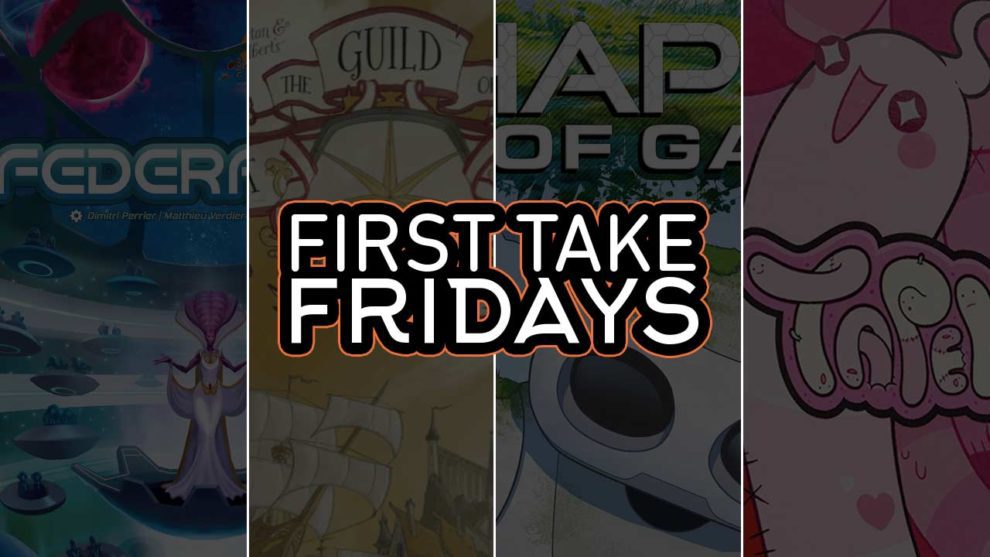Federation – David Wood
It’s the year 2442 and each player represents a small solar system competing to join a powerful Federation of planets. The game uses a unique double-sided worker placement mechanic. In addition to taking the action of the space where you placed your worker, each worker can either be used for its votes to influence the outcome of proposed legislation or to fund a major project. Actions can generate resources, increase your influence, give you access to bonus Special Mission actions, and much more. The actions, end of round voting results, and major projects all have the potential of earning players prestige points. The player with the most prestige after the fifth and final round wins.
Federation is a highly approachable game that is chock full of decision-making, yet it never feels overwhelming. There’s a great balance between player interaction and being able to focus on your own path to victory. So while there are plenty of different strategies players can take for racking up prestige, they must keep an eye on what their rivals are doing and block them if and when possible. Add high replay potential and the typically top notch components from Eagle Gryphon Games, and Federation is a great value.
Ease of entry?:
★★★★☆ – The odd bump or two
Would I play it again?:
★★★★★ – Will definitely play it again
Read more articles from David Wood
The Guild of Merchant Explorers – Bob Pazehoski, Jr.
Voyages is a 2021 Print-n-Play Roll-n-Write that takes place on a map of hexes depicting several islands scattered across a central sea. Players travel about collecting things, visiting things, connecting things. Voyages was designed by Matthew Dunstan and Rory Muldoon. When my kiddos first looked at The Guild of Merchant Explorers, they said, “Voyages!” It’s the same Matthew Dunstan (now with Brett Gilbert and publisher AEG) and the same hex-ploration in a wholly new package with a new central mechanic. The fresh ingredient is a pinch of Tiny Towns—the endearing part where someone shouts “brick!” when the last thing in the world you want is a brick. But both games are also functional and fun in the same way.
The Guild of Merchant Explorers is simple. Without hearing the rules explained, my five-year-old sat down and played. She only scored half the points I did, but she had no trouble tracking with the mechanics. In no way does this game set the world on fire, but it is easy to teach and easy to play, which seems to make it an ideal wide-ranging family and gateway gaming title. I have no plans to run out and buy it, but I wouldn’t turn it down were it to knock on my door. I’d happily sit in for another play. In the meantime, I have the wider world of Voyages at my fingertips when I’m looking for a quick hex map exploration.
Read our review of The Guild of Merchant Explorers.
Ease of entry?:
★★★★★ – No sweat
Would I play it again?:
★★★★☆ – Would like to play it again
Read more articles from Bob Pazehoski, Jr.
Shapers of Gaia – Tom Franklin
Think Terraforming Gaia while adding animals and you have the basic idea here. You’ll lay hex tiles on the planet board to create biomes and gain resources. You’ll spend those resources to populate those biomes with animals from your player board—animals that will reveal victory points. The more resources you can expend, of course, the more points the animals will score for you.
My gaming group is interested in returning to Gaia sooner than I am, but I’m willing to keep an open mind about this one.
Look for my full review in the coming weeks.
Ease of entry?:
★★★★☆ – The odd bump or two
Would I play it again?:
★★★☆☆ – Wouldn’t suggest it, but would happily play it
Read more articles from Tom Franklin.
Tapeworm – Justin Bell
Whenever I have a game that claims to be family weight in terms of rules, artwork and playtime, I get it to the table with my nine-year-old daughter first. That’s also a great gauge for whether or not the game works, because if it’s an engaging experience, she typically asks to play it again.
Tapeworm (2020, Maestro Media) was designed and drawn by Edmund McMillen, the video game designer behind a couple of my favorite games (Super Meat Boy and The Binding of Isaac). At the very least, that meant that replayability was a lock, because I couldn’t get enough of The Binding of Isaac when I first tried that “roguelite” more than 10 years ago. Sadly, as cool as the not-necessarily-family-friendly artwork is, the gameplay of Tapeworm is quite a miss.
Players start with a hand of five cards, featuring tapeworms that are available in four different colors. On a turn, you’ll draw a card then play a card off of existing routes matching the color of any previously-placed segments. If you happen to have a hand of more than one card of the same color, you can play as many as you can get onto the table. The win condition is simple: the first player to run out of cards wins. On our third play of Tapeworm, I went first and went out on that very same turn. You’re saying that in this game, someone can win simply by being the first player? Yikes.
Ease of entry?:
★★★★★ – No sweat
Would I play it again?:
☆☆☆☆☆ – No chance













Add Comment